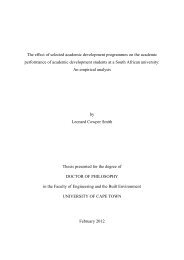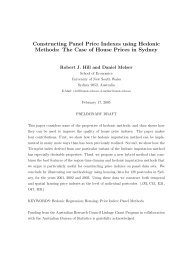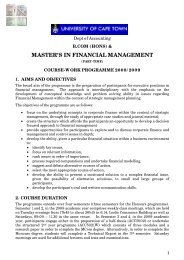USING THE SHARP EL 738 FINANCIAL CALCULATOR
USING THE SHARP EL 738 FINANCIAL CALCULATOR
USING THE SHARP EL 738 FINANCIAL CALCULATOR
You also want an ePaper? Increase the reach of your titles
YUMPU automatically turns print PDFs into web optimized ePapers that Google loves.
Some important things to consider<br />
<strong>USING</strong> <strong>THE</strong> <strong>SHARP</strong> <strong>EL</strong> <strong>738</strong> <strong>FINANCIAL</strong> <strong>CALCULATOR</strong><br />
Basic financial examples with financial calculator steps<br />
Prepared by Colin C Smith 2010<br />
1. These notes cover basic financial calculations using the <strong>SHARP</strong> <strong>EL</strong><strong>738</strong> financial calculator. The notes do not deal<br />
with the underlying theory and/or formulae. Students should ideally have a working knowledge of the undelying<br />
theory.<br />
2. At best these notes are designed to get you started. They do not claim to be a comprehensive guide to the use of<br />
your calculator. Consult your user manual for more information and further examples.<br />
3. The logic used in approaching these examples will be similar to the logic used when performing manual<br />
calculations – the interest rate is converted to a periodic interest rate ( i / m) and the number of years will be<br />
converted to compounding periods (n x m).<br />
4. Financial calculators have functionality not available to the human brain and the multi‐functionality of financial<br />
calculators is not demonstrated in these notes. If you use different functionality and get the same answer –<br />
congratulations ‐ you are an advanced financial calculator user. If you use different functionality and do not get<br />
the same answer follow our basic steps and read your manual to learn more.<br />
INDEX<br />
Getting Started<br />
Lump sums – Present Values and Future values<br />
Lump sums – Interest Rates and Periods, and Nominal and Effective Interest Rates<br />
Annuities – Ordinary annuities and annuities due<br />
Amortisation – Calculating the annual amount of interest paid and capital repaid<br />
Bond valuation – Calculating the value of annual, semi‐annual compounded bonds and calculating<br />
the yield to maturity<br />
Net Present Value and Internal Rate of Return<br />
Page<br />
2<br />
3<br />
4<br />
5 ‐ 6<br />
7 ‐ 9<br />
10<br />
11
GETTING STARTED<br />
There are a few things you need to do before we can start with the calculations.<br />
FUNCTION SET‐UP<br />
The <strong>SHARP</strong> <strong>EL</strong><strong>738</strong> is already set up as a financial calculator so it is not necessary to set a particular mode.<br />
SETTING PAYMENTS PER PERIOD<br />
In these notes, we use the same logic used with<br />
manual calculations and set our payments to one<br />
payment per period.<br />
DECIMAL PLACES<br />
To set your calculator to the conventional two<br />
decimal places or four decimal places.<br />
DECIMAL POINT<br />
The <strong>SHARP</strong> <strong>EL</strong><strong>738</strong> is already set up using a point as the decimal indicator.<br />
CLEARING PREVIOUS WORK<br />
Every transaction in this document will commence<br />
with the following keystrokes. CA is the function to<br />
clear all the internal registers of the calculator.<br />
SETTING FOR PAYMENTS AT BEGINNING OF <strong>THE</strong> PERIOD<br />
If you are working with an annuity due you must set<br />
your calculator to peform caluations from the<br />
beginning of the period. If you are doing lump‐sum<br />
calculations or ordinary annuities check to see that<br />
your calculator is correctly set and does not dispay<br />
“BGN”<br />
<strong>SHARP</strong> <strong>EL</strong><strong>738</strong> Financial Calculator<br />
KEYS DISPLAY<br />
2ndF P/Y 1 ENT 1.00<br />
ON/C 1.00<br />
<strong>SHARP</strong> <strong>EL</strong><strong>738</strong> Financial Calculator<br />
KEYS DISPLAY<br />
SET UP 0 0 2 0.00<br />
SET UP 0 0 4 0.0000<br />
<strong>SHARP</strong> <strong>EL</strong><strong>738</strong> Financial Calculator<br />
KEYS DISPLAY<br />
2ndF CA 0.0000<br />
<strong>SHARP</strong> <strong>EL</strong><strong>738</strong><br />
KEYS DISPLAY<br />
If it does display BGN 0.00<br />
2ndF BGN<br />
Removes this 0.00<br />
Colin C Smith 2010 2
LUMPSUMS – FUTURE VALUES AND PRESENT VALUES<br />
* see getting started<br />
1. Simple Future Value (FV)<br />
You borrow R5,000 from a friend at 8% p.a. interest<br />
to be compounded annually. Capital and interest is<br />
repayable in 5 years time. How much will you repay?<br />
2. Future Value (FV) with frequent compounding<br />
You have saved R10,000 and invest this in a fixed<br />
deposit with a bank at 10.5% compounded quarterly<br />
for 4 years. How will you receive in 4 years time?<br />
3. Simple Present Value (PV)<br />
You have just turned 20 years of age and your late<br />
Uncle Scrooge bequeathed you an amount of R5,000<br />
payable on your 25 th birthday. Your father offers to<br />
give you the present value today in cash. At an<br />
interest rate of 10% p.a. compounded annually how<br />
much must your father give you today? What is the<br />
present value of the bequest?<br />
The –ve amount reflects what should be paid today.<br />
4. Present Value (PV) with frequent compounding<br />
Uncle George is more generous and leaves you a<br />
substantial inheritance. You want to set aside and<br />
amount to buy your dream car when you complete<br />
your trainee contract in 5 years time. Estimates are<br />
that the dream car will cost R220,000 at that time.<br />
A bank is offering you a 5 year fixed deposit at<br />
11.5% compounded monthly for 5 years. How much<br />
should you invest today?<br />
The –ve amount reflects what should be paid today.<br />
<strong>SHARP</strong> <strong>EL</strong><strong>738</strong> Financial Calculator<br />
KEYS DISPLAY<br />
*Must not display BGN<br />
2ndF CA 0.0000<br />
5,000 +/‐ PV ‐5,000.00<br />
8 I/Y 8.00<br />
5 N 5.00<br />
COMP FV 7,346.64<br />
<strong>SHARP</strong> <strong>EL</strong><strong>738</strong> Financial Calculator<br />
KEYS DISPLAY<br />
*Must not display BGN<br />
2ndF CA 0.00<br />
10,000 +/‐ PV ‐10,000.00<br />
10.5 ÷ 4 I/Y 2.63<br />
4 x 4 N 16.00<br />
COMP FV 15,137.38<br />
<strong>SHARP</strong> <strong>EL</strong><strong>738</strong> Financial Calculator<br />
KEYS DISPLAY<br />
*Must not display BGN<br />
2ndF CA 0.00<br />
5,000 FV 5,000.00<br />
10 I/Y 10.00<br />
5 N 5.00<br />
COMP PV ‐3,104.61<br />
<strong>SHARP</strong> <strong>EL</strong><strong>738</strong> Financial Calculator<br />
KEYS DISPLAY<br />
*Must not display BGN<br />
2ndF CA 0.00<br />
220,000 FV 220,000.00<br />
11.5 ÷ 12 I/Y 0.96<br />
5 x 12 N 60.00<br />
COMP PV ‐124,134.45<br />
Colin C Smith 2010 3
LUMPSUMS –INTEREST RATE AND PERIODS, AND NOMINAL AND EFFECTIVE INTEREST RATES<br />
These calculations are quite challenging in an equation format but much easier with a financial calculator.<br />
* see getting started<br />
5. Calculating the interest rate<br />
An amount of R400,000 is invested in a savings<br />
account that compounds interest monthly. After<br />
one year the balance in the account is R464 301.81.<br />
Calculate the nominal interest rate (i.e. the quoted<br />
rate or APR).<br />
The R400,000 is shown as a –ve as this is the cash<br />
outflow required now.<br />
6. Calculating the periods<br />
An amount of R100,000 was invested in an account<br />
that accumulates interest at a rate of 14% per<br />
annum, compounded quarterly. The balance in the<br />
account, immediately after the latest quarter’s<br />
interest credit is R173,398.60. How long ago was<br />
the amount invested?<br />
Remember that because you have compounded<br />
more than once a year (n x m in the formula) N is<br />
not years but periods. So the answer is 16 ÷ 4 = 4<br />
years.<br />
7. Calculating the effective rate<br />
Calculate the effective rate of 13% per annum<br />
compounded monthly.<br />
This reflects the compounding periods per year (m in<br />
the formula) and can be changed to any frequency.<br />
8. Calculating the nominal or annual percentage rate (APR)<br />
Calculate the nominal rate (APR) of 14.9342% per<br />
annum compounding monthly.<br />
This reflects the compounding periods per year (m in<br />
the formula) and can be changed to any frequency.<br />
<strong>SHARP</strong> <strong>EL</strong><strong>738</strong> Financial Calculator<br />
KEYS DISPLAY<br />
*Must not display BGN<br />
2ndF CA 0.00<br />
464,301.81 FV 464,301.81<br />
400,000 +/‐ PV ‐400,000.00<br />
1 x12 N 12.00<br />
COMP I/Y 1.25<br />
X 12 15<br />
<strong>SHARP</strong> <strong>EL</strong><strong>738</strong> Financial Calculator<br />
KEYS DISPLAY<br />
*Must not display BGN<br />
2ndF CA 0.00<br />
173,398.60 FV 173,398.60<br />
100,000 +/‐ PV ‐100,000.00<br />
14 ÷ 4 I/Y 3.50<br />
COMP N 16.00<br />
<strong>SHARP</strong> <strong>EL</strong><strong>738</strong> Financial Calculator<br />
KEYS DISPLAY<br />
*Must not display BGN<br />
2ndF CA<br />
12 (x,y) 0.00<br />
13 2ndF EFF 13.80<br />
<strong>SHARP</strong> <strong>EL</strong><strong>738</strong> Financial Calculator<br />
KEYS DISPLAY<br />
*Must not display BGN<br />
2ndF CA<br />
12 (x,y) 0.0000<br />
12.68 2ndF APR 14.00<br />
Colin C Smith 2010 4
ANNUITIES – ORDINARY, DUE, FUTURE VALUE, PRESENT VALUE<br />
* see getting started<br />
9. Simple Future Value of an Ordinary Annuity (FVA)<br />
Assume you put R1,000 into a savings account at the<br />
end of every year for 10 years at 9.5% interest<br />
compounded annually. How much will you have in<br />
the account after 10 years?<br />
10. Simple Future Value of an Annuity Due (FVAdue)<br />
Assume you put R1,000 into a savings account at the<br />
beginning of every year for 10 years at 9.5% interest<br />
compounded annually. How much will you have in<br />
the account after 10 years?<br />
11. Present Value of an Annuity Due (PVAdue)<br />
An overseas benefactor has offered to sponsor new<br />
Care Centre for Aids Orphans in Cape Town and they<br />
have pledged to provide the equivalent of R25,000<br />
per month for the next four years payments starting<br />
immediately. The benefactor will make a single<br />
investment lump sum investment into a bank<br />
account paying 9.5% interest. How large will this<br />
initial investment be?<br />
Colin C Smith 2010<br />
<strong>SHARP</strong> <strong>EL</strong><strong>738</strong> Financial Calculator<br />
KEYS DISPLAY<br />
*Must not display BGN<br />
2ndF CA 0.00<br />
1,000 +/‐ PMT ‐1,000.00<br />
9.5 I/Y 9.50<br />
10 N 10.00<br />
0 PV 0.00<br />
COMP FV 15,560.29<br />
<strong>SHARP</strong> <strong>EL</strong><strong>738</strong> Financial Calculator<br />
KEYS DISPLAY<br />
*Must display BGN<br />
2ndF CA 0.00<br />
2ndF BGN/END BGN 0.00<br />
1,000 +/‐ PMT ‐1,000.00<br />
9.5 I/Y 9.50<br />
10 N 10.00<br />
0 PV 0.00<br />
COMP FV 17,038.52<br />
<strong>SHARP</strong> <strong>EL</strong><strong>738</strong> Financial Calculator<br />
KEYS DISPLAY<br />
*Must display BGN<br />
2ndF CA 0.00<br />
2ndF BGN/END BGN 0.00<br />
2ndF P/Y 1 ENT 1.00<br />
ON/C 0.00<br />
25,000 +/‐ PMT ‐25,000.00<br />
9.5 ÷12 I/Y 0.79<br />
4 x 12 N 48.00<br />
0 FV 0.00<br />
COMP PV 1,002,976.54<br />
5
ANNUITIES – ORDINARY, DUE, FUTURE VALUE, PRESENT VALUE<br />
12. Calculating the payment (PMT) for a normal financial transaction ‐ Annuity Due<br />
You buy a new car today for R120 000 and<br />
obtain finance for 80% of the purchase price<br />
(R96,000) over four years. The bank quotes<br />
you a finance rate of 12% per annum<br />
(nominal rate). Instalments are payable<br />
monthly in advance. Calculate the monthly<br />
instalment.<br />
You can also solve for the interest rate and for the number of periods using the same functions.<br />
13. Calculating the interest rate for a normal financial transaction ‐ Annuity Due<br />
A bank offers you a personal loan of<br />
R20,000 repayable in 24 easy instalments<br />
of R1,050 per month starting immediately.<br />
What nominal interest rate (APR) is being<br />
charged?<br />
Additional notes:<br />
Please also see the Bond Valuation section for similar transactions.<br />
Colin C Smith 2010<br />
<strong>SHARP</strong> <strong>EL</strong><strong>738</strong> Financial Calculator<br />
KEYS DISPLAY<br />
*Must display BGN<br />
2ndF CA 0.00<br />
2ndF BGN/END BGN 0.00<br />
2ndF P/Y 1 ENT 1.00<br />
ON/C 0.00<br />
96,000 +/‐ PV ‐25,000.00<br />
12 ÷12 = I/Y 1.0<br />
4 x12 = N 48.00<br />
0 FV 0.00<br />
COMP PMT ‐2,503.02<br />
<strong>SHARP</strong> <strong>EL</strong><strong>738</strong> Financial Calculator<br />
KEYS DISPLAY<br />
*Must display BGN<br />
2ndF CA 0.00<br />
2ndF BGN/END BGN 0.00<br />
2ndF P/Y 1 ENT 1.00<br />
ON/C 0.00<br />
20,000 PV 24,000.00<br />
0 FV 0.00<br />
1,050 +/‐ PMT ‐1,050.00<br />
24 N 24.00<br />
COMP PMT 2.12<br />
X 12 25.48<br />
Where we have irregular cash flow payments, we cannot use the annuity functionality and instead can use the NET<br />
PRESENT VALUE and INTERNAL RATE OF RETURN functions.<br />
6
AMORTISATION<br />
* see getting started<br />
N.B. ENSURE THAT YOU CORRECTLY IDENTIFY YOUR PAYMENTS AS AN ORDINARY ANNUITY OR AN ANNUITY DUE<br />
AND SET YOUR <strong>CALCULATOR</strong> ACCORDINGLY.<br />
14.1 Calculating the intalment /payment (PMT) for a normal financial transaction ‐ Annuity Due with amortisation<br />
A company takes a loan of R100,000 loan repayable<br />
in equal month instalments, at the beginning of the<br />
month, over a period of two years term, an interest<br />
rate of 12% per year is quoted by the bank (this is<br />
the nominal or Annual Percentage Rate APR.<br />
This is your monthly instalment.<br />
14.2 <strong>THE</strong> AMORTISATION SCHEDULE – ANNUITY DUE<br />
<strong>SHARP</strong> <strong>EL</strong><strong>738</strong> Financial Calculator<br />
KEYS DISPLAY<br />
*Must display BGN<br />
2ndF CA 0.00<br />
2ndF BGN/END BGN 0.00<br />
2ndF P/Y 1 ENT 1.00<br />
ON/C 0.00<br />
100,000 PV 100,0000.00<br />
0 FV 0.00<br />
12 ÷ 12 I/Y 1.00<br />
2 x 12 N 24.00<br />
COMP PMT ‐4,660.74<br />
We could derive the interest payments by preparing a manual amortisation schedule (very time consuming) or one below<br />
using Microsoft Excel (not allowed in examinations).<br />
‡ In an annuity due the entire first payment is applied to capital<br />
Year 1 interest<br />
R8,385.86<br />
Year 2 interest<br />
R3,471.88<br />
Month Instalment Interest Capital paid off Capital Balance<br />
today 100,000.00<br />
1 R 4,660.74 ‐ ‡ 4,660.74 95,339.26<br />
2 R 4,660.74 953.39 3,707.35 91,631.91<br />
3 R 4,660.74 916.32 3,744.42 87,887.49<br />
4 R 4,660.74 878.87 3,781.87 84,105.63<br />
5 R 4,660.74 841.06 3,819.68 80,285.94<br />
6 R 4,660.74 802.86 3,857.88 76,428.06<br />
7 R 4,660.74 764.28 3,896.46 72,531.60<br />
8 R 4,660.74 725.32 3,935.42 68,596.18<br />
9 R 4,660.74 685.96 3,974.78 64,621.40<br />
10 R 4,660.74 646.21 4,014.53 60,606.87<br />
11 R 4,660.74 606.07 4,054.67 56,552.20<br />
12 R 4,660.74 565.52 4,095.22 52,456.99<br />
13 R 4,660.74 524.57 4,136.17 48,320.82<br />
14 R 4,660.74 483.21 4,177.53 44,143.28<br />
15 R 4,660.74 441.43 4,219.31 39,923.98<br />
16 R 4,660.74 399.24 4,261.50 35,662.48<br />
17 R 4,660.74 356.62 4,304.12 31,358.36<br />
18 R 4,660.74 313.58 4,347.16 27,011.20<br />
19 R 4,660.74 270.11 4,390.63 22,620.58<br />
20 R 4,660.74 226.21 4,434.53 18,186.04<br />
21 R 4,660.74 181.86 4,478.88 13,707.16<br />
22 R 4,660.74 137.07 4,523.67 9,183.49<br />
23 R 4,660.74 91.83 4,568.91 4,614.59<br />
24 R 4,660.74 46.15 4,614.59 ‐0.00<br />
Year 1 capital<br />
R47,543.02<br />
Year 2 capital<br />
R52,457.00<br />
Colin C Smith 2010 7
AMORTISATION<br />
14.3 Amortising the payments using a financial calculator to calculate the amount of capital and interest paid and<br />
the balance at the end of each year<br />
This step follows directly on your calculation of the instalment above.<br />
We enter the first financial period and the<br />
number of payments made in that period<br />
Note: You can set the amortisation function for<br />
any period but here it is for a 12‐month period.<br />
This is for periods 1 ‐ 12<br />
Balance at the end of year 1<br />
Capital paid in year 1<br />
Interest paid in year 1<br />
For the next 12 months (periods 13 – 24)<br />
Balance at the end of year 2<br />
Capital paid in year 2<br />
Interest paid in year 2<br />
<strong>SHARP</strong> <strong>EL</strong><strong>738</strong> Financial Calculator<br />
KEYS DISPLAY<br />
AMRT 1 ENT 1.00<br />
12 ENT 12.00<br />
52,456.98 <br />
‐47,543.02 <br />
‐8,385.86 <br />
<strong>SHARP</strong> <strong>EL</strong><strong>738</strong> Financial Calculator<br />
13 ENT 13.00<br />
24 ENT 24.00<br />
‐0.02 <br />
‐52,457.00 <br />
‐3,471.88 <br />
YOU CAN CHECK <strong>THE</strong>SE NUMBERS AGAINST <strong>THE</strong> AMORTISATION SCHEDULE in section 14.2 that was completed using<br />
Microsoft Excel.<br />
15.1 Calculating the intalment /payment (PMT) for a financial transaction – Ordinary Annuity with amortisation<br />
A company takes a loan of R100,000 loan repayable<br />
in equal month instalments, at the end of the<br />
month, over a period of two years term, an interest<br />
rate of 12% per year is quoted by the bank (this is<br />
the nominal or Annual Percentage Rate APR.<br />
This is your monthly instalment.<br />
<strong>SHARP</strong> <strong>EL</strong><strong>738</strong> Financial Calculator<br />
KEYS DISPLAY<br />
*Must not display BGN<br />
2ndF CA 0.00<br />
2ndF P/Y 1 ENT 1.00<br />
ON/C 0.00<br />
100,000 PV 100,0000.00<br />
0 FV 0.00<br />
12 ÷ 12 I/Y 1.00<br />
2 x 12 N 24.00<br />
COMP PMT ‐4,707.35<br />
Colin C Smith 2010 8
AMORTISATION<br />
15.2. <strong>THE</strong> AMORTISATION SCHEDULE – ORDINARY ANNUITY<br />
As for the schedule at 14.2 this was prepared using Microsoft Excel.<br />
Year 1 interest<br />
R9,469.73<br />
Year 2 interest<br />
R3,506.61<br />
Month Instalment Interest Capital paid off Capital Balance<br />
today 100,000.00<br />
1 R 4,707.35 1,000.00 3,707.35 96,292.65<br />
2 R 4,707.35 962.93 3,744.42 92,548.23<br />
3 R 4,707.35 925.48 3,781.86 88,766.37<br />
4 R 4,707.35 887.66 3,819.68 84,946.68<br />
5 R 4,707.35 849.47 3,857.88 81,088.80<br />
6 R 4,707.35 810.89 3,896.46 77,192.34<br />
7 R 4,707.35 771.92 3,935.42 73,256.92<br />
8 R 4,707.35 732.57 3,974.78 69,282.14<br />
9 R 4,707.35 692.82 4,014.53 65,267.62<br />
10 R 4,707.35 652.68 4,054.67 61,212.95<br />
11 R 4,707.35 612.13 4,095.22 57,117.73<br />
12 R 4,707.35 571.18 4,136.17 52,981.56<br />
13 R 4,707.35 529.82 4,177.53 48,804.03<br />
14 R 4,707.35 488.04 4,219.31 44,584.72<br />
15 R 4,707.35 445.85 4,261.50 40,323.22<br />
16 R 4,707.35 403.23 4,304.12 36,019.10<br />
17 R 4,707.35 360.19 4,347.16 31,671.95<br />
18 R 4,707.35 316.72 4,390.63 27,281.32<br />
19 R 4,707.35 272.81 4,434.53 22,846.79<br />
20 R 4,707.35 228.47 4,478.88 18,367.91<br />
21 R 4,707.35 183.68 4,523.67 13,844.24<br />
22 R 4,707.35 138.44 4,568.90 9,275.33<br />
23 R 4,707.35 92.75 4,614.59 4,660.74<br />
24 R 4,707.35 46.61 4,660.74 0.00<br />
15.3 Amortising the payments to calculate the amount of capital and interest paid and the balance at the end of<br />
each year<br />
This step follows directly on your calculation of the instalment above.<br />
We enter the first financial period and the<br />
number of payments made in that period. The<br />
amortisation function can be for any period but<br />
here it is for a 12‐month period.<br />
This is for periods 1 ‐ 12<br />
Balance at the end of year 1<br />
Capital paid in year 1<br />
Interest paid in year 1<br />
For the next 12 months (periods 13 – 24)<br />
Balance at the end of year 2<br />
Capital paid in year 2<br />
Interest paid in year 2<br />
<strong>SHARP</strong> <strong>EL</strong><strong>738</strong> Financial Calculator<br />
KEYS DISPLAY<br />
AMRT 1 ENT 1.00<br />
12 ENT 12.00<br />
52,981.53 <br />
‐47,018.47 <br />
‐9,469.73 <br />
<strong>SHARP</strong> <strong>EL</strong><strong>738</strong> Financial Calculator<br />
KEYS DISPLAY<br />
13 ENT 13.00<br />
24 ENT 24.00<br />
‐0.06 <br />
‐52,981.59 <br />
‐3,506.61 <br />
YOU CAN CHECK <strong>THE</strong>SE NUMBERS AGAINST <strong>THE</strong> AMORTISATION SCHEDULE ABOVE.<br />
Year 1 capital<br />
R47,018.47<br />
Year 1 capital<br />
R52,981.59<br />
Colin C Smith 2010 9
BOND VALUATION<br />
* see getting started<br />
16. Value of an annual payment bond with a single annual payment<br />
A company purchases bonds on 1 January of this<br />
year. The nominal/face/coupon value is R1,000 and<br />
the annual nominal/coupon interest rate is 10%. The<br />
bond is redeemable on 31 December 6 years later.<br />
The market interest rate for similar bonds is 15%.<br />
Assume that the bond payments are made annually<br />
in arrears. What price would the company pay for<br />
the bond? (i.e. what should the value be on 1<br />
January of this year?<br />
17. Value of a typical government bond with semi‐annual payments<br />
Assume same information as for 16 above except<br />
that the bond is a typical government bond that<br />
pays semi‐annually in arrears. What price would the<br />
company pay for the bond?<br />
18. Calculating the yield to maturity<br />
<strong>SHARP</strong> <strong>EL</strong><strong>738</strong> Financial Calculator<br />
KEYS DISPLAY<br />
*Must not display BGN<br />
2ndF CA 0.00<br />
15 I/Y 15.00<br />
6 N 6.00<br />
1,000 FV 1,000.00<br />
100 PMT 100.00<br />
COMP PV ‐810.78<br />
<strong>SHARP</strong> <strong>EL</strong><strong>738</strong> Financial Calculator<br />
KEYS DISPLAY<br />
*Must not display BGN<br />
2ndF CA 0.00<br />
15 ÷ 2 I/Y 7.50<br />
6 x 2 N 12.00<br />
1,000 FV 1,000.00<br />
50 PMT 50.00<br />
COMP PV ‐806.62<br />
This is extremely difficult to calculate when using a formula approach without a financial calculator.<br />
The nominal/face/coupon value is R1,000 and the<br />
annual nominal/coupon interest rate is 10% paid<br />
semi annually in arrears. You purchased the bond on<br />
1 January of this yearand the bond is redeemable on<br />
31 December 10 years later at a premium of 10%.<br />
The bond is priced at R980 on 1 January of this year.<br />
What is the yield to maturity on 1 January of this<br />
year?<br />
◊ This takes a while and your display will be<br />
blank.<br />
‡ Remember that this is the rate for 6 months.<br />
To annualise the convention (from bond trading<br />
in the United States) has been to multiply this<br />
by 2.<br />
<strong>SHARP</strong> <strong>EL</strong><strong>738</strong> Financial Calculator<br />
KEYS DISPLAY<br />
*Must not display BGN<br />
2ndF CA 0.00<br />
10 x 2 N 20.00<br />
1,000 x 1.10 FV 1,100.00<br />
980 +/‐ PV ‐980.00<br />
50 PMT 50.00<br />
COMP I/Y ◊ 5.45<br />
X 2 10.91<br />
‡<br />
Colin C Smith 2010 10
NET PRESENT VALUE and INTERNAL RATE OF RETURN<br />
* see getting started<br />
19 & 20. What is the Net Present Value and IRR of this project?<br />
A project has the following cash flows<br />
Year Cash Flow (R)<br />
0 ‐1,000<br />
1 ‐1,700<br />
2 1,500<br />
3 1,800<br />
4 1,900<br />
If the weighted average cost of capital WACC is 15 %<br />
what is the Net Present Value of this project?<br />
What is the Internal Rate of Return of the<br />
above cash flows?<br />
<strong>SHARP</strong> <strong>EL</strong><strong>738</strong> Financial Calculator<br />
KEYS DISPLAY<br />
*Must not display<br />
BGN<br />
CFi 2ndF CA 0.00<br />
ON/C 0.00<br />
1,000 +/‐ DATA 0.00<br />
1,700 +/‐ DATA 1.00<br />
1,500 DATA 2.00<br />
1,800 DATA 3.00<br />
1,900 DATA 4.00<br />
ON/C 0.00<br />
2ndF CASH 2ndF CA<br />
15 ENT 15.00<br />
NPV COMP 925.82<br />
2ndF CASH 2ndF CA<br />
IRR COMP 31.54<br />
Colin C Smith 2010 11

















